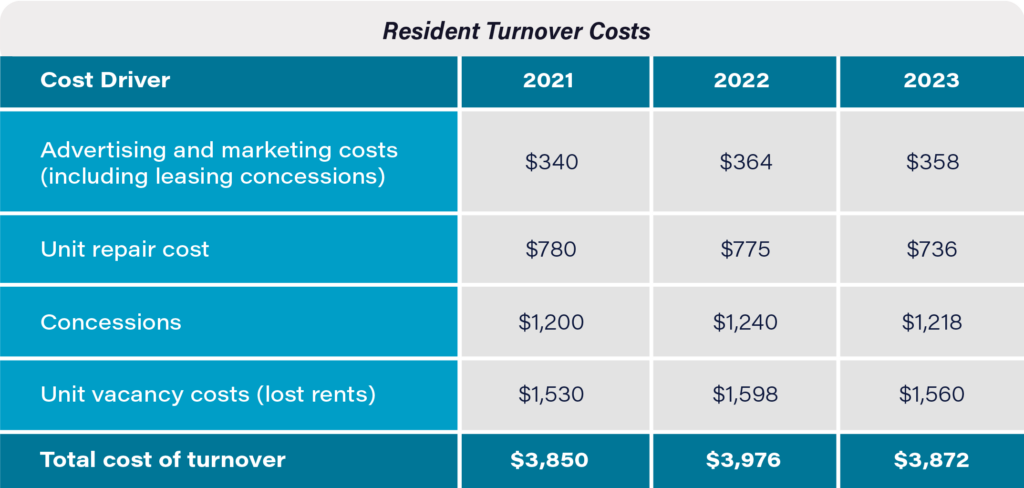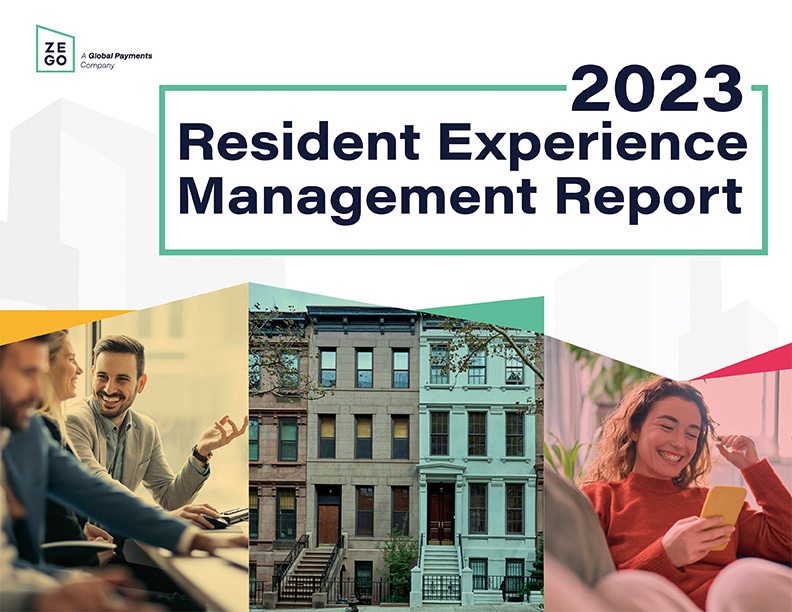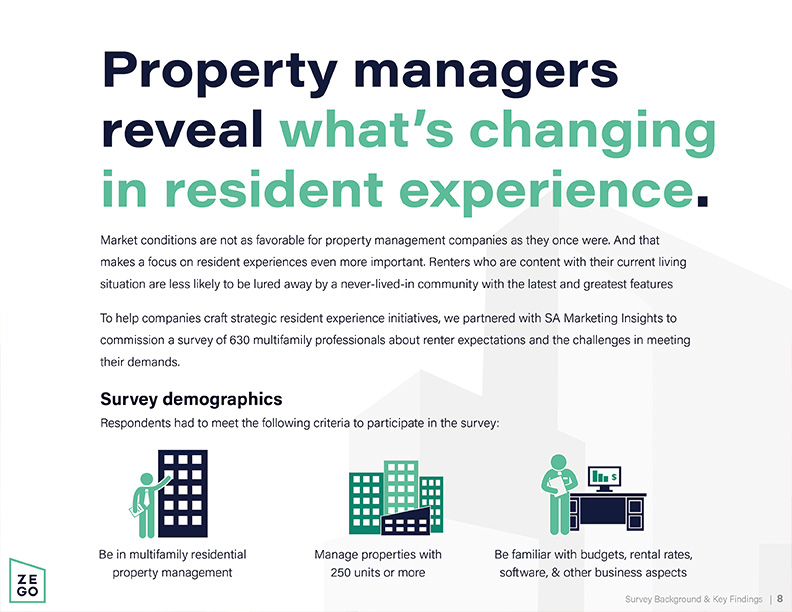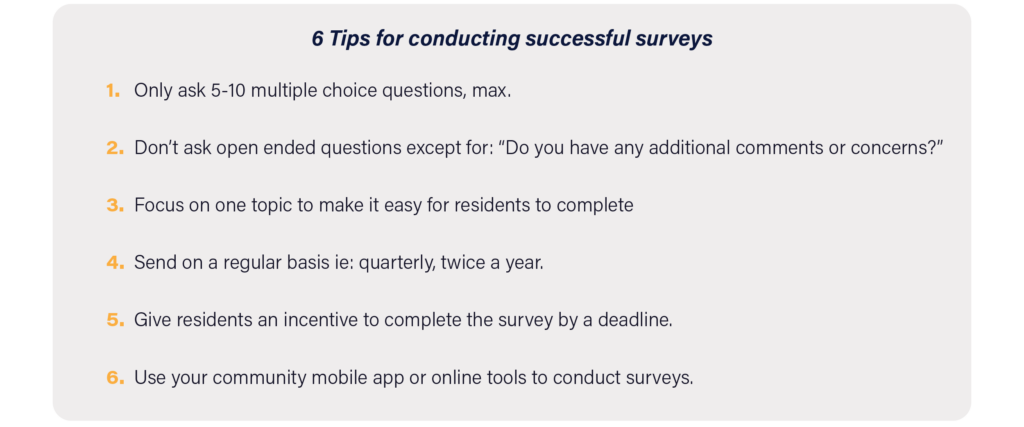4 modern strategies to improve resident satisfaction
As featured on Multifamily and Affordable Housing Business
With these 4 tips, improve resident satisfaction and meet the needs of today’s renter.
Property managers are always looking for ways to improve resident satisfaction. But these days, that’s not so easy.
That’s because renters have higher standards about their living experience than they once did. Zego’s 2023 Resident Experience Management Report asked property managers how renter expectations have changed. Out of 600 property managers, 75% say that renters have higher expectations than a year ago.
Why is resident satisfaction important?
The biggest reason multifamily resident satisfaction is important is because it affects the financial performance of your company.
A recent study shows that great customer experiences grow revenue. Companies usually earn 140% more from customers who’ve had positive experiences with a business than the ones who had mediocre or negative experiences. Not only that, but customers who had good experiences are likely to remain customers for five years longer than ones who have had negative experiences.
Think about how that translates to the multifamily industry. Renters who are happy with their community often renew their leases time and time again. But those who aren’t happy move out, leaving you with the costs to turn that unit. Based on our research, each instance of turnover costs about $4,000!

Granted, there are always reasons beyond your control that lead residents to move. But all other factors equal, communities that deliver positive resident experiences have much higher retention rates and lower turnover costs.
Resident satisfaction tips for today’s market
Resident satisfaction will always be dependent upon good customer service and a pleasant living experience. But as the market evolves, there are some extra tactics you need to adopt to keep renters happy. Here’s how to meet the demands of today’s renter.
#1 Resident satisfaction increases with the right balance of automation & human interaction
Zego’s Resident Experience Management Report looks at how staff happiness affects renter satisfaction. And our data shows that being short staffed or having overwhelmed on-site teams hurts resident satisfaction. As a result, it leads to high levels of resident turnover.
This is why on-site team duties need to be shifted in favor of resident interactions. Teams that focus on resident satisfaction bring your organization the most value – not teams that are buried under dozens of manual tasks.
The best way to get teams focused on residents is to automate the low-value tasks. Automation relieves your team members from boring tasks that don’t add value to their job. And it also increases resident satisfaction. Automation resolves issues faster and more efficiently, leading to happier residents.
That said, apartment communities thrive when there’s a good relationship between on-site teams and residents. Finding the right balance between automated workflows and human touch is essential. Your goal is to provide residents good customer service and to reduce stress for on-site associates.
Automation that increases resident satisfaction
Property managers can automate almost everything. So how do you choose where to devote your resources? Your best bet is to automate the most cumbersome tasks that often pull your team members away from resident interactions.
You may already rely on automation in some shape or form. However, many solutions leave gaps throughout the end-to-end process that employees have to resolve. That just pulls them away from residents.
Think about how these three areas are conducted at your company. Ask yourself if there are any opportunities to improve the workflow:
- Resident payments
- Utility management
- Resident related tasks
Automating resident payments
Resident satisfaction increases when you offer renters a variety of payment options. However, about 40% of payments are paper-based, which provides manual work for your team. So converting those stragglers into digital transactions is a must. With three essentials, you can fully automate rent collection:
- Lockbox: Move checks offsite and converts them to digital payments
- CashPay: Convert cash and money orders to digital payments
- Comprehensive online payments : Accept all forms of integrated online payments: ACH, Debit card, Credit card, & virtual wallets like PayPal
It’s not just paper payments that get teams tangled up. You also want a solution that takes charge of issues that arise after a payment is made. Revenue protection services resolve situations that can be costly and quite time-consuming for property managers like:
- Chargebacks
- NSF returns
- Delinquent funds
Automating utility management
Utility management is a task that property managers hate the most. That’s because much of the process is performed manually. This makes it low-hanging fruit for teams that want to improve their efficiency. There are facets of utility management where automation is used:
- Utility Expense Management: The entire utility accounts payable process from invoice receipt to payment can be automated. This lets companies eliminate errors and late fees, and gain visibility into critical, portfolio-wide utility metrics.
- Resident Utility Billing: Recover resident’s share of utility expenses without performing complicated calculations. Renters receive an individualized statement that reflects their utility charges, rent, and all other monthly ancillary charges. Statements contain a link to pay all of their charges at once so you receive a single, convenient digital transaction.
Resident-Related Tasks
Modern mobile apps simplify tasks that pertain to daily living. Residents can self-serve instead of waiting on a community associate to help them. And that’s a key way to improve resident satisfaction. Associates use a single app to centralize and automate resident activity. Automation in community mobile apps improves the following tasks:
- Resident communications: real-time & scheduled messaging with push notifications
- Maintenance requests: submit and track work orders
- Package notifications: notify residents of package delivery
- Amenity reservations: view and reserve amenities
- Guest entrants: register guests, deliveries, and entrants
- Online payments: pay rent and property charges


FREE GUIDE
2023 Resident Experience Management Report
Learn the newest trends in resident experience and how companies are applying them to attract and retain more renters. Based on survey data from over 600 property management companies, this free report details what it takes to thrive in this new era.
#2 Bring community technology to Gen Z standards
According to our survey respondents, a tech-enabled lifestyle is the most important aspect of the resident experience. Not only that, but property managers say that renters have increased their expectations of community technology in the past year. In other words, the technology in your communities plays a big role in resident satisfaction.
There’s no one with higher technology expectations than Gen Z. And, they just happen to have recently taken over as the largest segment of renters.
When community technology doesn’t meet their standards, they’re likely to go somewhere else – even when everything else checks all of their boxes. A recent survey finds that 62% of Gen Z renters considered community technology as being an “extremely” or “very important” leasing factor. Gen Z also stated that modern community technology is even more essential in a rental than having an extra bedroom.
It’s not just fast wifi they crave either. They also cite a desire for a mobile app to manage rent and maintenance, as well as smart locks, thermostats and energy-efficient appliances.
Gen Z property managers want modern technology, too
Gen Z isn’t just taking over as the primary demographic of renters. They are also entering the workforce at higher rates. And remember, staffing shortages are hurting resident satisfaction. Therefore, it’s wise to take Gen Z’s work preferences into account in order to attract and retain their promising talent.
Gen Z is not keen on performing mundane or manual tasks. They prefer to work for businesses that embrace technology to optimize workflows. A study by Zapier found that 1 in 6 Gen Z employees have quit a job because their employer did not provide the proper technology for them to do their job. And, nearly all Gen Z employees (95%) say they are willing to automate parts of their job to avoid performing mundane work.
Automation doesn’t just help teams accomplish more with less. It helps overcome staffing shortages by offering an appealing employee experience. Keep these statistics in mind when thinking about the employee experience for on-site teams. Many of these positions are likely being filled by Gen Z’ers. Utilizing automation to minimize some of the mundane aspects of property management will help retain these workers.
#3 Use surveys to monitor resident satisfaction and potential turnover
Surveying renters and acting on their feedback will always be a good practice. And this tactic will be even more critical for resident satisfaction success in 2024. That’s because current market conditions will potentially lead to a wave of resident turnover.
3 market factors hurting resident retention
- Renters have increased their expectations of their community in the past year
- Renters have more choice thanks to a flood of new inventory
- Yet companies say they are going to retain more renters next year
This is why companies should continually monitor resident satisfaction. Between rising renter expectations and new inventory, listening to resident feedback is more important than ever.
Send resident satisfaction surveys each quarter
Asking residents for feedback will help you keep tabs on resident sentiment. Hopefully that will prevent a lot of surprise turnover. Quarterly surveys are frequent enough where residents will remember any issues or positive experiences.
Once you get survey responses, you should acknowledge that they were heard. If you can’t implement their suggestions let them know you appreciate their feedback and offer an alternative solution.
Don’t forget move-out surveys!
When renters leave your community, don’t just accept it as a loss and move on. In this market, it’s important to know why that resident is leaving. If there are any trends you may be able to fix those problems so that others don’t follow suit for the same reason. Send existing residents a quick survey after they give notice to vacate to understand why they decided to leave.

#4 Improve maintenance workflows for techs and residents
Property managers say that a top struggle with resident satisfaction is resolving maintenance issues. In fact, the NMHC Resident Preferences Report showed that 31% of residents said maintenance was a factor in their decision to leave a community.
Property maintenance and updates should be completed without burdening residents or draining your team members. If you don’t have the right work order management system, property updates will only cause headaches. Ultimately, that leads to decreased resident satisfaction and unhappy maintenance techs.
Maintenance app features that improve resident satisfaction
Some renters accept that things need to be repaired from time to time. Others are irritated when something doesn’t work perfectly.
However your renter feels about maintenance, the process for resolving it can profoundly impact resident satisfaction. Here are three key features a work order management system needs on the resident facing side.
- Easy to initiate: One way to increase a renter’s frustration about something being broken in their apartment is to make them call or email a property manager. Contactless, self-service options are far more convenient for residents. Ideally, they can submit and track service requests through their community-branded resident experience app.
- Details, please!: Your platform should allow them to submit a ticket in just a few steps. But they also need the capabilities to elaborate on a request – not just check a box on what’s wrong. When they can add their own details or pictures to the work order it helps communicate the problem so your technician arrives prepared.
- Status updates: Residents want to stay updated about the maintenance process from the moment they submit a request to the minute the issue is fixed. A work order platform should generate updates so your techs or your on-site teams don’t have to continually contact the resident.
Improve resident satisfaction in your multifamily communities
With multifamily turnover costs being about $4,000 a resident, it’s imperative to focus on your current residents. And with renter expectations soaring, providing a top-tier resident experience is a necessity.
Elevate your resident experience
With Zego, you can not only boost resident satisfaction but also improve NOI. Request a demo and see how you can elevate your resident satisfaction game, reduce turnover costs, and take your multifamily community to new heights.